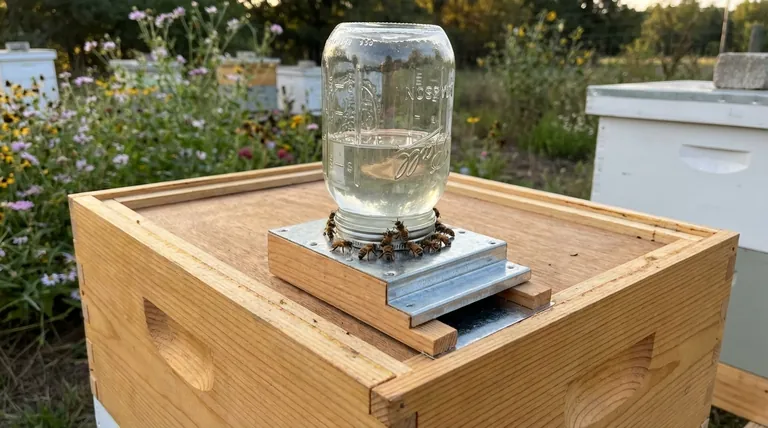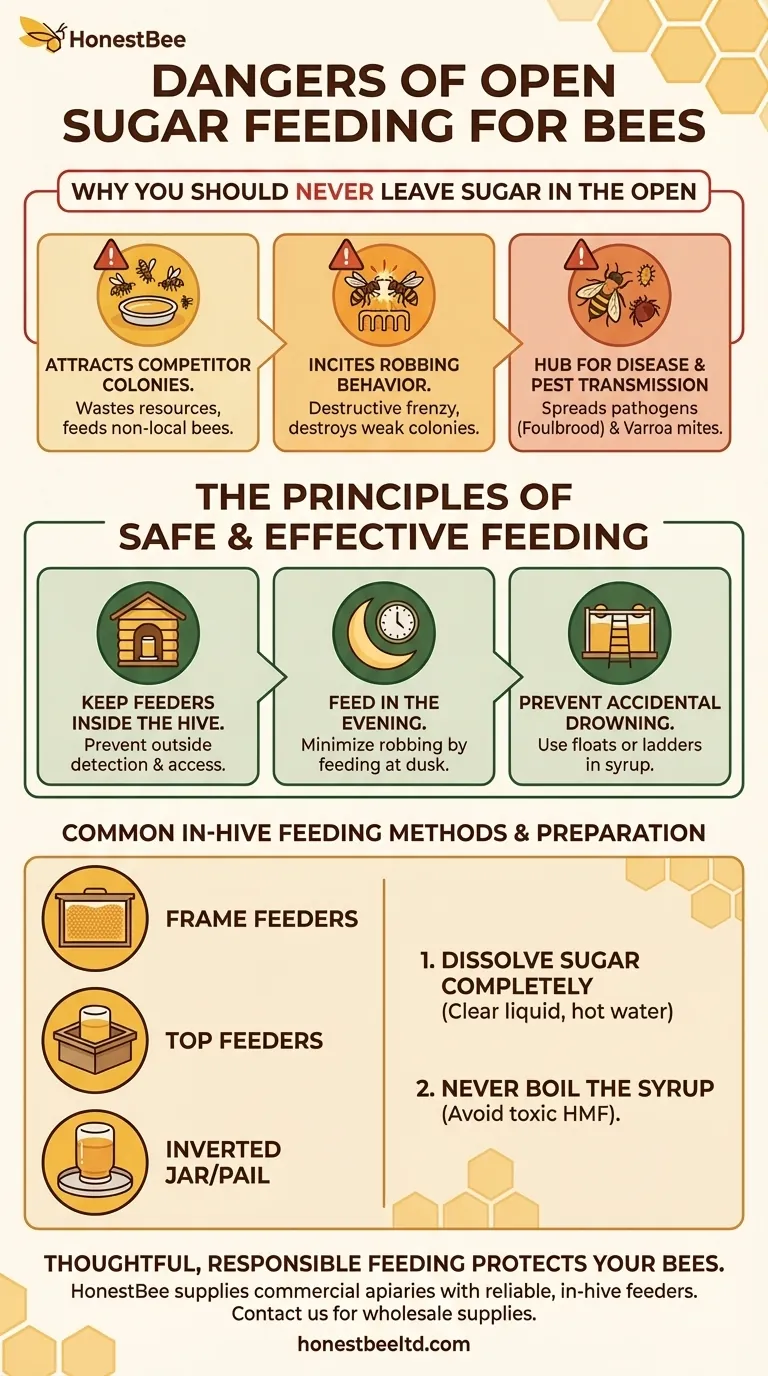In short, you should never leave sugar out in the open because it is a dangerous and counterproductive practice. Open feeding creates a chaotic "feeding frenzy" that attracts bees from competing colonies, promotes aggressive robbing behavior between hives, and creates a perfect hub for spreading diseases and pests throughout the local bee population. It fundamentally undermines the goal of supporting your specific colony.
The core principle of supplemental feeding is to provide resources directly and exclusively to your bees. Open feeding does the opposite: it creates a public feeding station that wastes your resources, endangers your hives, and threatens the health of the entire local bee ecosystem.

The Dangers of Open Feeding
When you place a food source in the open, you are sending an invitation to every bee, wasp, and ant within a multi-mile radius. This creates a cascade of negative consequences that go far beyond simply feeding the wrong bees.
It Attracts Competitor Colonies
The primary goal of feeding is to strengthen your colonies, not your neighbor's. The powerful scent of sugar water will be detected by foraging bees from nearby managed hives and feral colonies, who will quickly exploit the easy food source.
You end up spending time and money to feed countless bees that are not your own, diluting the benefit intended for your hives.
It Incites Robbing Behavior
Robbing is one of the most destructive events in an apiary. It occurs when bees from a strong colony overwhelm and steal the honey stores of a weaker colony, often killing the resident bees and queen in the process.
Open feeding trains bees to seek out easy sugar sources. Once the open feeder is empty, these bees don't simply return to foraging for nectar. They begin investigating other hives, searching for that same easy reward. This can trigger a robbing frenzy that can destroy a weak or small colony in a matter of hours.
It Creates a Hub for Disease Transmission
A communal, open feeder is the ideal environment for spreading pathogens and pests. Bees from dozens of different colonies—each with its own potential health issues—congregate in one small space.
This is how diseases like foulbrood and pests like Varroa mites can rapidly spread from one colony to another. An open feeder effectively becomes a disease super-spreader event for the local bee population.
The Principles of Safe and Effective Feeding
The solution is to use feeding methods that contain the food source entirely within the hive, making it accessible only to the colony that needs it.
Keep Feeders Inside the Hive
The most fundamental rule is to place the feeder inside the physical structure of the hive. This prevents outside bees from detecting and accessing the syrup. Common methods include frame feeders, top feeders, and inverted pails placed over the inner cover.
Feed in the Evening
Feeding your bees towards dusk minimizes the risk of inciting robbing. It gives your colony's bees the entire night to consume much of the syrup and clean up any small spills.
By the time foraging bees from other colonies become active the next morning, the potent scent of fresh sugar syrup has largely dissipated.
Prevent Accidental Drowning
Bees can easily drown in open pools of syrup. Always use feeders designed to prevent this.
Many top feeders have built-in floats or textured walls that allow bees to climb out. If using a simple container or frame feeder, be sure to add floats like wood chips, corks, or even just rough sticks to give the bees a safe place to stand.
Common In-Hive Feeding Methods
Several proven methods exist for feeding bees safely inside the hive. The best choice often depends on the scale of your operation and your specific goals.
Frame Feeders
These are thin, plastic containers shaped like a hive frame. They are placed inside the hive body in place of a brood or honey frame. They are discreet but can sometimes lead to bees drowning if no floats are provided.
Top Feeders
These are large trays or reservoirs that sit on top of the uppermost hive box, directly under the outer cover. They hold a large volume of syrup and often have built-in ladders or floats to protect the bees.
Inverted Jar or Pail Feeders
This is a very popular method for hobbyists. A Mason jar or bucket is filled with syrup, and the lid is perforated with tiny holes. The container is then inverted over the hole in the hive's inner cover. Vacuum pressure prevents the syrup from dripping out, but bees can drink it directly from the holes.
A Note on Syrup Preparation
How you prepare the syrup is just as important as how you deliver it.
Dissolve Sugar Completely
Use hot—but not boiling—water to dissolve the sugar completely. A common ratio for fall feeding is 2 parts sugar to 1 part water by weight. The resulting liquid should be clear.
Never Boil the Syrup
Boiling sugar water or scorching the sugar can produce a compound called Hydroxymethylfurfural (HMF). While harmless to humans, HMF is toxic to bees and can cause dysentery and death. Simply use hot water and stir until the sugar is fully dissolved.
Making the Right Choice for Your Goal
Always choose a feeding method that protects your bees and prevents access by outsiders.
- If your primary focus is simplicity and ease of use: An inverted jar feeder is an excellent choice that allows you to easily monitor syrup levels.
- If your primary focus is providing a large volume of feed: A top feeder or a large inverted pail feeder is the most efficient option.
- If your primary focus is minimizing hive invasions: A frame feeder is the most contained method, though it requires opening the hive to refill.
Thoughtful, responsible feeding is a cornerstone of beekeeping that protects your investment and the health of the entire bee community.
Summary Table:
| Danger of Open Feeding | Consequence |
|---|---|
| Attracts Competitor Colonies | Wastes resources; feeds bees that aren't yours |
| Incites Robbing Behavior | Can lead to weaker colonies being destroyed |
| Spreads Disease & Pests | Creates a hub for transmitting mites and foulbrood |
Protect your apiary with the right equipment. Responsible feeding starts with reliable, in-hive feeders. HONESTBEE supplies commercial apiaries and beekeeping equipment distributors with the wholesale-focused supplies needed to manage colonies safely and efficiently. Ensure the health of your investment—contact our experts today to discuss your equipment needs.
Visual Guide

Related Products
- Boardman Entrance Bee Feeder Durable Galvanized Steel and Wood Construction for Beekeeping
- Professional Hive Top Bee Feeder for Beekeeping
- HONESTBEE Entrance Bee Feeder Professional Hive Nutrition Solution for Beekeeping
- Professional Hive Front Entrance Bee Feeder
- HONESTBEE Professional Hive Top Bee Feeder Feeding Solution
People Also Ask
- What is an entrance feeder? A Guide to Its Simple Design and High Robbing Risk
- How does a bee entrance feeder work? A Simple Guide to Convenient Hive Feeding
- How does an entrance feeder work? A Guide to Its Simple Mechanics and Risks
- How to make an entrance feeder for bees? A DIY Guide for Safe & Effective Feeding
- What types of bee feeders are available for beginners? Start with the Simple Entrance Feeder



















